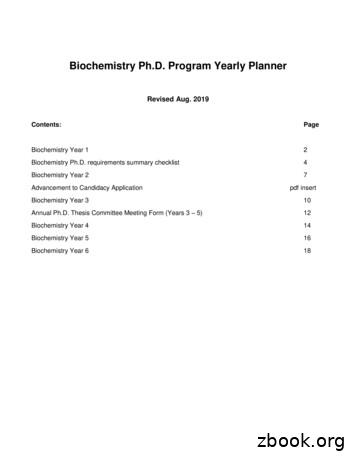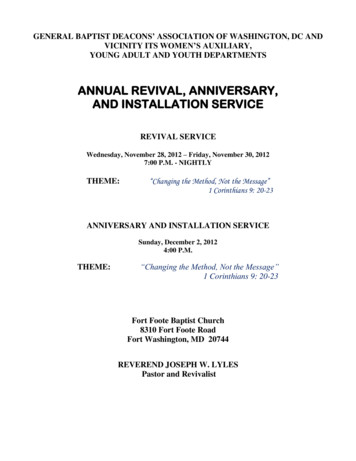Apicomplexan Biochemistry Basics
Apicomplexan Biochemistry Basics Toxoplasma Cryptosporidium Good cell biology modelGenome sequencing not completedVirtual pathwaysThe “strange one”Genome sequence completedVirtual pathwaysPlasmodium Best biochemistry dataNumerous studies over many yearsGenome sequencing completed!Glycolysis - Plasmodium Erythrocytic stage Pentose PathwayInfected RBC’s utilize 75%more glucose than uninfectedLactate is major end product Glucose-6-PGlucose is major substrateLactate85% of glucose lactateHigh glycolytic rateEnzyme utilize ATP (not PPi)Overall 2 ATP produced forevery glucose utilizedPyruvatePEPPyruvate MetabolismRole of mitochondrion?Pentose PhosphatePathway* Glycolytic intermediate isutilized (G-6-P)Reducing equivalentsgeneratedProducts utilized forNucleotide metabolismProducts utilized forshikimate pathwayRegenerates someglycolytic albiosyntheticpathway1
Shikimate PathwayGlycolysisImportant pathway that isabsent from animals! PPPFolate synthesisAromatic amino acidsynthesisEssential for apicomplexanparasitesLarge body of data onbiochemistry Bacteria, fungi, SynthesisMitochondrial Function Simplified View? Historically thought to bequiescentFew if any cristaeDevelopmental changes Asexual stages Gametocytes Single mitochondrion tubularnetworkMultiple organellesBasics - Asexual stage Cytosolic glycolysis Complete complement of TCAcycle enzymesElectron transport subunitsAlternative oxidaseMito Oxidative PhosphorylationApicomplexans sTrypanosomaBloodstream form2
Puzzle of Pyruvate MetabolismAcetyl-CoAPyruvate Dehydrogenase ComplexMultienzyme complex (PDC) E1 - pyruvate dehydrogenaseE2 - dihyrolipoyl transacteylaseE3 - dihydrolipoyl dehydrogenaseConvert Pyruvate to Acetyl-CoA,generate reducing equivalentsTypically the regulated step committingto TCA cycle PDC is absent from mitochondriaPDC is present in apicoplastE3 subunits present in mitochondriaEndocytosis of Host Cytoplasm PinocytosisCytostomeEndocytic pathwayFood Vacuole Hemoglobin digestionheme destabilizes and lysesmembranes hydrolases released intoparasite cytoplasmparasite diesHemeβ-hematin3
The Plasmodium Food VacuoleA specialized lysosome - acidic compartmentATPhemoglobinO2plasmepsinFe 2 Fe 3 -O O22superoxidedismutase?H2O2H globinheme fragments?falcipainhemozoinMalaria pigmentcatalase?H2O O 2ADPaminoacidsplasmepsinfalcilysinsmall fragments Pfmdr-1?(6-8 amino acids)ATPADPThe Power of Genomics Hugely difficult to isolate intactapicoplasts in pure form. Why? How do you study the function? Virtual pathways! Confirmation!!!!!Delayed Death Phenotype Ciprofloxacin inhibited apicoplast DNA replication(T. gondii)Treatment resulted in: Loss of apicoplast DNACell growth inhibited after 1 round ofcell division4
Apicoplast functions - -phosphateDOXP pathway:Bacteria, chloroplasts***Transporters:Plant-like*Apicoplast is an essential organelle - delayed death phenotypeAn Unusual DNA PolymeraseFatty Acid Synthesis Iterative elongation ofacyl chains Growth of chain by 2 CType I (Eukaryotic) Dr. Kim PaulMultiple enzymaticactivities on a singlelarge multifunctionalproteinType II (Prokaryotic) Each activity is on aseparate polypeptide5
Inhibition of Type II FAS Initially thought: no FASType II - prokaryotic Separate subunitsACC - acetyl CoA carboxylase Aryloxyphenoxyproprionateherbicides (FOPS)ACP - acyl carrier proteinKAS - keto-acyl ACP synthase ThiolactomycinCeruleninENR - enoyl reductase Triclosan The Good, the Bad, the UglyThe really ugly What purpose do Triclosan and the Copolymerserve?When flushed into water systems, and exposed toultra violet radiation, triclosan converts to a dioxin.The amount of dioxins created is small, however,it's an extremely toxic and stable chemical thatpersists in the environment and is eliminatedslowly from the body.Colgate Total is the only toothpaste to contain triclosanwith a copolymer.Sewage sludge - commonly used on farmer’s fieldsTriclosan is an effective antibacterial ingredient, whichis effective in controlling a wide range of bacteria.The copolymer is used in the formulation to prolongretention of triclosan on oral hard and soft tissues andin plaque.Without the copolymer, triclosan would be rapidly lostfrom the mouth, reducing its clinical effect. Bottom line:Isoniazid1st line anti-tuberculosisInhibits mycolic acid synthesis (mycobacterial cell wall)Drug resistance is a big problem.Never use Isoniazid alone.(numerous studies)Antibacterial ingredient triclosan degrades rapidlywhen exposed to chlorinated tap water, producingpotentially toxic byproducts (chloroform).Mycolic acids consist of long-chainalpha-alkyl-beta-hydroxy fatty acids that areproduced by successive rounds of elongation catalyzedby a type II fatty acid synthase (FAS-II).Apicoplast functions - -phosphateDOXP pathway:Bacteria, chloroplasts***Transporters:Plant-like*Apicoplast is an essential organelle - delayed death phenotype6
Presence of PlastidFatty acid biosynthesis Cytosol - animalsPlastidLocation of HaembiosynthesisClose association betweenplastid and mitochondrionALA aminolevulinic acid Early precursor of haembiosynthesis Mitochondrial!!!!!7
2 Shikimate Pathway Important pathway that is absent from animals! Folate synthesis Aromatic amino acid synthesis Essential for apicomplexan parasites Large body of data on biochemistry Bacteria, fungi, plants Glycolysis PPP Folate Synthesis Ubiquinone Synthesis Tryptophan
Parasites of animals Life cycles involve at least two types of hosts Schizogony is a major feature of apicomplexan life cycles Asexual reproduction producing multinucleate schizonts before the cells divide 4 important apicomplexan parasites Plasmodium, Toxoplasma, Cryptosporidium, Cyclospora Apicomplexans
4. Plant Biochemistry 5. Clinical Biochemistry 6. Biomembranes & Cell Signaling 7. Bioenergetics 8. Research Planning & Report Writing (Eng-IV) 9. Nutritional Biochemistry 10. Bioinformatics 11. Industrial Biochemistry 12. Biotechnology 13. Immunology 14. Current Trends in Biochemistry
1. Fundamentals of Biochemistry by J.L. Jain 2. Biotechnology by B.D., Singh 3. Principles of Biochemistry by Lehninger, Nelson & Cox 4. Outlines of Biochemistry by Conn & Stumpf 5. Textbook of biochemistry by A VSS, Ramarao 6. An Introduction to Practical Biochemistry by D.T. Plummer 7. Laboratory Manual in Biochemistry by Jairaman
Advancement to Candidacy Application pdf insert Biochemistry Year 3 10 Annual Ph.D. Thesis Committee Meeting Form (Years 3 – 5) 12 Biochemistry Year 4 14 Biochemistry Year 5 16 Biochemistry Year 6 18
Analytical Biochemistry (Textbook) Analytical Biochemistry, 2nd edition, by D.J. Holme and H. Peck, Longman, 1993 Available on Reserve. Physical Biochemistry (Textbook) Physical Biochemistry (2nd edition, 1982) D. Freifelder (QH 345.F72). This is a particularly good reference text for spectroscopy, centrifugation, electrophoresis, and other .
Department of Biochemistry - Website information 1. Department: Biochemistry 2. About Department The Department of Biochemistry was instituted as one of the departments of Sciences in the academic year 1998-1999. 3. Objective & Scope To enable the students to understand the concept of biochemistry regarding biomolecules
Department of Biochemistry Introduction: The dynamic department of Biochemistry is spear headed by our worthy principal Lt Gen Abdul Khaliq Naveed (HI) who is a pioneer in the field of medical biochemistry, chemical pathology and medical genetics. He is presiding over the national Society of Medical Biochemistry (SOMB).
ANNUAL REVIVAL, ANNIVERSARY, AND INSTALLATION SERVICE REVIVAL SERVICE Wednesday, November 28, 2012 – Friday, November 30, 2012 7:00 P.M. - NIGHTLY THEME: “Changing the Method, Not the Message” 1 Corinthians 9: 20-23 ANNIVERSARY AND INSTALLATION SERVICE Sunday, December 2, 2012 4:00 P.M. THEME: “Changing the Method, Not the Message” 1 Corinthians 9: 20-23 Fort Foote Baptist Church .























